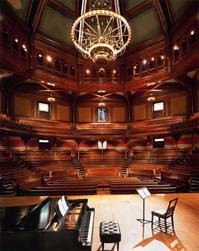Week 10 (11/13)
8 Harvard Buildings for People With Megalophobia to Avoid
Megalophobia is an irrational fear of large objects, which for me, manifests as being terrified that large or precarious structures will fall on me, and/or that I will fall off of them. I have compiled a list of eight buildings for people to avoid on campus if they suffer from the same affliction, or for lovers of large and seemingly unsupported structures to visit if they please.
8. Science Center
The Science Center is not THAT big or tall, coming in at only 8 stories. However, it does have several rooftop terraces with only minimal protection from falling. In addition, the presence of an observatory is another reason for megalophobes to avoid, as staring into the sky or space for too long can give one the fear of falling into their immensity.
 |
| Science Center, photo courtesy of Harvard University |
7. Harvard Art Museums
Also not very tall at only 5 stories, the gaping atrium within, and delicate glass pyramid atop, Renzo Piano's redesigned Harvard Art Museums do make me shiver just a tad when crossing the internal courtyard. Also, the installation of Triangle Constellation by Carlos Amorales introduced large metal structures dangling from the atrium's ceiling, menacing megalophobic observers below.
 |
| Harvard Art Museums' atrium from the top floor, photo by Greg Cook |
 |
| Seating in Harvard Stadium, photo by Lisa Kennelly |
5. Sanders Theater, Memorial Hall
Sanders Theater is impressive in its ability to make one appreciate the immensity of space while containing it within a building. The pointed arches above truly make an observer appreciate the height of the ceiling and a megalophobe cower in the shadow of the huge lighting fixture hanging from it.
 | |
| Sanders Theater, courtesy of Harvard University | |
4. William James Hall
At 215 feet, William James Hall stands out from its low-lying neighbors, competing with Memorial Hall across the street. The perception of its largeness is only mitigated by the gentle curve in the vertical elements of the facade, which is more perceptible in person than in the image below.
 | |
| William James Hall, courtesy of Harvard University | |
3. Mather House
Though firmly anchored by the surrounding 5-story low-rise, Mather House's skinny tower shoots up to a frightening 19 floors. Its size seems to grow when viewing from the south side of Flagg Street, as the flanking low rise is less visible.
 |
| Mather Tower, courtesy of Gabby Malatesta, Harvard College Student Blog |
2. Peabody Terrace
Looking to the opposite direction on Flagg Street, one finds the three, even taller towers of Peabody Terrace, rising to 22 stories each. The courtyard in between the three offers dizzying views upward as the viewer is trapped on almost all sides by their ascendant forms, seemingly unrooted to the ground below.
 | |
| One of the three Peabody Terrace towers, courtesy of Harvard University Housing | |
1. One Western Ave
I find the worst building on campus for my megalophia is One Western. Standing on the south side of the Charles River, it consists of a U-shaped building, with a tower at one end and the gap between ends bridged by an immense overhanging structure that is just ACHING to fall down on people below. I have tried to subject myself to sitting in the outdoor lounge below but I only lasted 30 seconds before by heart rate raised to concerning levels. This building terrifies me and I assume it will do the same to fellow sufferers of megalophobia.
 |
| One Western Ave, photo by Michael Moran Photography, Inc. via Architype Review |

Comments
Post a Comment